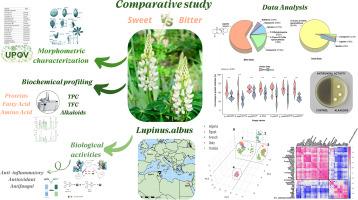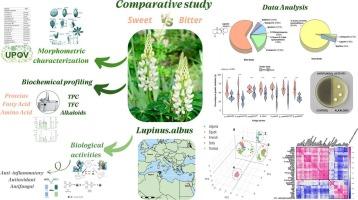不同来源白豆苦、甜基因型的靶向植物化学分析及功能评价
IF 9.8
1区 农林科学
Q1 CHEMISTRY, APPLIED
引用次数: 0
摘要
由于生物碱含量高,传统上被排除在食品使用之外的苦味白Lupinus基因型被重新评估为未充分利用的生物活性植物化学物质来源。本研究对苦、甜两种基因型进行了农业形态和生化对比分析。目标GC-MS分析显示,苦味类型的植物物候发育加快,硬脂酸、白酸和α-亚麻酸水平显著提高。它们还显示出增强的抗氧化能力(DPPH IC₅₀:23.4 ± 2.1 vs. 41.2 ± 3.7 μg/mL)和更强的脂氧化酶抑制活性。羽扇豆氨酸是苦味种子中主要的生物碱,而芥酸仍在可接受的饮食限制范围内。甜基因型保持低生物碱含量和有利的脂肪酸比例。抑菌试验表明苦味型对尖锐炭疽病菌的抑制作用较强。主成分分析强调了基于物候、生化和功能性状的明确的基因型依赖聚类。这些结果支持了苦荞麦在功能性食品中的应用和旨在提高其营养特性的育种策略。本文章由计算机程序翻译,如有差异,请以英文原文为准。


Targeted phytochemical profiling and functional evaluation of bitter and sweet Lupinus albus genotypes from diverse origins
Bitter Lupinus albus genotypes, traditionally excluded from food use due to high alkaloid levels, are reassessed as underutilized sources of bioactive phytochemicals. This study conducted a comparative agro-morphological and biochemical analysis of bitter and sweet genotypes. Targeted GC–MS profiling revealed that bitter types exhibited accelerated phenological development and significantly higher levels of stearic, behenic, and α-linolenic acids. They also demonstrated enhanced antioxidant capacity (DPPH IC₅₀: 23.4 ± 2.1 vs. 41.2 ± 3.7 μg/mL) and stronger lipoxygenase-inhibitory activity. Lupanine was the dominant alkaloid in bitter seeds, while erucic acid remained within acceptable dietary limits. Sweet genotypes maintained low alkaloid content and favourable fatty acid ratios. Antifungal assays indicated stronger inhibition of Colletotrichum acutatum by bitter types. Principal component analysis highlighted clear genotype-dependent clustering based on phenological, biochemical, and functional traits. These results support the valorisation of bitter L. albus for functional food applications and breeding strategies aimed at enhancing nutritional properties.
求助全文
通过发布文献求助,成功后即可免费获取论文全文。
去求助
来源期刊

Food Chemistry
工程技术-食品科技
CiteScore
16.30
自引率
10.20%
发文量
3130
审稿时长
122 days
期刊介绍:
Food Chemistry publishes original research papers dealing with the advancement of the chemistry and biochemistry of foods or the analytical methods/ approach used. All papers should focus on the novelty of the research carried out.
 求助内容:
求助内容: 应助结果提醒方式:
应助结果提醒方式:


